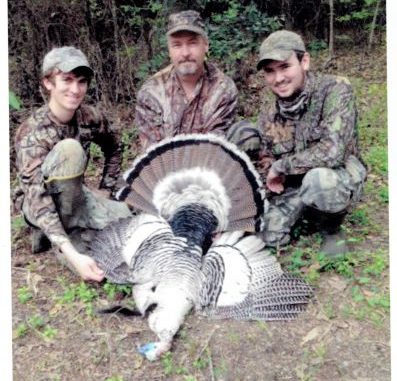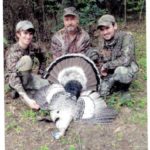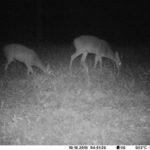
Jimmy Stafford plans to stay active with wildlife activities
In the early ’80s, a young college graduate from Louisiana Tech was hired by the Louisiana Department of Wildlife and Fisheries as a wildlife specialist on Pearl River WMA.
I was the District Seven game supervisor, and Mark Bible was the area supervisor on Pearl River.
When Mark read the name Norman J. Stafford III, he was a little concerned about what kind of person had been hired to work on the area — but he soon found out Jimmy was a keeper.
Jimmy, a native of Franklinton, had graduated from Tech with a degree in Forestry/Wildlife Management and was eager to go to work. He was one of those guys who always wanted to work outdoors and probably would have worked for peanuts (which is about what the state paid him back then).
Within a few years, Jimmy moved up to a game biologist position. His familiarity with the Florida Parishes and the various habitat types in this region made him a valuable asset for the district. He grew up hunting in this area and knew the territory quite well.
He was heavily involved with the DMAP Program and because of his hunting background could relate to landowners and hunting clubs. And he also trapped turkeys for release throughout the state.
He was working when Sandy Hollow WMA and the now-defunct Bens Creek WMA came on the scene, and he was instrumental in the development of these two areas. Sandy Hollow was best known for quail and doves, and while Bens Creek was a popular area for deer hunting Jimmy helped develop the turkey population there.
Over time he conducted a gobbler mortality study on the Bens Creek, demonstrating how hunting pressure impacts bird populations.
Because of his expertise with wild turkeys, quail and doves, Jimmy became the upland game and small game biologist. He conducted other turkey nesting, mortality and movement studies on wildlife management areas, the Kisatchie National Forest and on private lands.
He also helped coordinate activities between the department and the Louisiana Chapter of the National Wild Turkey Federation, and he was involved with establishing turkey hunting seasons based on the biology of the wild turkey — not an easy task in this state.
Turkey youth hunting seasons were one of his priorities.
After a long, successful stint, Jimmy is retiring from state government. But he will continue to be active with managing habitat for both quail and turkey.
He and his wife Tina have two sons, and all four of them are serious hunters, especially when it comes to turkey hunting.
The oldest son, David James, is working on a master’s degree in forestry and wildlife at Tech , while his younger brother Brandon is studying wetlands ecology at LSU.
There is a high possibility that another Stafford will be working for LDWF in the near future.
We at the Sportsman wish Jimmy and his family the very best in the years to come.
It is also worth noting that Scott Durham, our state deer biologist, is moving up in the world: He’s been named the biologist director for the LDWF Wildlife Division’s Research Section. Instead of just deer research and management, Scott will now be working with waterfowl, turkeys, deer, bear and all the other game critters that are studied and managed by the department.
Hunt the food sources this season and fill a tag
Moving on to hunting, October was a tough month for hunters, wildlife and wildlife habitat. The rains that were so abundant in the spring and early summer disappeared in late summer.
In fact, Northwest Louisiana had to endure almost three months of no rainfall. The habitat was stressed because of the lack of rain, and soaring temperatures that often peaked in the mid-90s further reduced the soil moisture.
It is amazing to see how much water a tree can soak up over time. No wonder important shrubs such as french mulberry were dried up by mid-October. The purple fruit produced by this shrub, which is readily eaten by deer, was brown and dried up.
The abundant mast crop also began to fall from the oaks because of the drought.
It took a major hurricane in the Pacific to end the drought — and did it ever end it. We went from drought to flooding overnight, but I am not complaining.
I was fortunate that morning dews kept most of my food plots alive, and some actually grew during the days of no rain and high heat.
I had planted an early strip of winter forage with purple hull peas mixed in for the October bow season.
But the heat kept me out of the deer stand — I just cannot hunt when the temperature is 80 degrees or higher — but the peas were growing well, and in early October they were flowering and making peas.
I gave a deer talk in mid-October to a gathering of men at a church and told the group that I probably was going to pick a mess of peas from the strip, which is one reason I had mixed the peas in. However, a few days later I discovered that the only thing left of the peas were leafless stems.
The deer had literally eaten all of the leaves and young peas in just a matter of days.
Oh well: The peas provided the deer with a few nights of quality eating. This is one reason that when you plant a plot with the idea of providing forage for deer growth, it needs to be large enough so it will provide nutrition over many weeks and not just a few days.
Many hunters and landowners were waiting for the rain so they could plant their food plots. Now is the time to put the seed in the ground.
Because I planted in early September I have a jump start with my food plots. Following the rain I simply went in and filled in some empty spaces with wheat, clover and greens.
If you planted early and the seed did not germinate, you could simply sow new seed on top of the ground. There are mixes of no-till seed available at seed stores, but winter grasses and clover will germinate simply from broadcasting on the ground — and you could make your own special mix.
All across the state deer have been feeding heavily on corn and rice bran in preparation for the upcoming breeding season. However, following the heavy rain that swept across the state, I noticed there were a lot of acorns on the ground, so if you are not seeing much activity around the feeders, get in the woods and check the oak trees.
There is a heavy water oak acorn crop this year around the state. In the Morganza area, the striped oak trees are loaded again, and I found high numbers of acorns on cow oaks and overcup oaks at Pearl River.
The native browse plants on which deer feed disappear and become dormant as the fall season progresses, so food plots will come into play and should provide them with high-quality forage during the winter months.
This could be a year during which food plots will actually attract and hold deer during the deer season because of the drought and its impact on the native vegetation.
Don’t forget to report your harvest: The department needs the best information possible in order to give us the best possible seasons. They do their part by providing us with good hunter opportunity, so we need to do our part and give them good harvest data.
Hunt hard but be safe.




